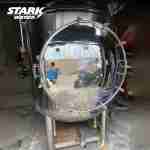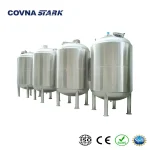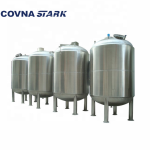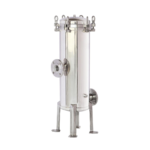Bag Filters vs. Cartridge Filters: Which One Is Right for Your Process?
When it comes to liquid filtration in industrial settings, bag filters and cartridge filters are two of the most commonly used options. While both serve to remove suspended solids from water or process fluids, they differ significantly in design, efficiency, maintenance requirements, and cost structure.
Choosing the right filter type can affect everything from product quality and system uptime to operational costs and safety compliance. This article compares bag and cartridge filters across key performance criteria to help you determine which is best suited for your specific application.
What Is a Bag Filter and How Does It Work?
A bag filter is a filtration system that uses a fabric bag—typically made of polypropylene, polyester, or nylon—as the filter media. Fluid enters the housing and passes through the filter bag, where particles are captured and retained inside. Bag filters are valued for their simplicity, large dirt-holding capacity, and relatively low cost.
Key Features of Bag Filters:
- Micron ratings typically range from 1 to 200 μm
- Available in single-bag or multi-bag housings
- Easy to replace; suitable for high-flow, low-solid applications
- Less prone to clogging in batch processes or low-viscosity fluids
Bag filters are widely used in cooling water systems, chemical processing, paint production, and wastewater polishing. Their ease of operation and lower maintenance make them ideal for applications where absolute precision is not critical.
If you're considering a bag filter system, explore our full range of stainless steel and industrial-grade options here:
STARK Stainless Steel Bag Filters.
What Is a Cartridge Filter and How Does It Work?
Cartridge filters are precision filtration systems that use cylindrical filter elements—known as cartridges—to trap fine particles within the media. These filters are housed in stainless steel or plastic casings and are commonly used where higher filtration accuracy and cleanliness are required.
Key Features of Cartridge Filters:
- Available in various configurations: pleated, melt-blown, string-wound, or depth-type
- Micron ratings typically range from 0.2 to 50 μm
- Supports multi-stage filtration for critical processes
- Ideal for high-purity applications and systems with tight quality control
Cartridge filters are commonly found in RO pre-treatment units, pharmaceutical water systems, food & beverage processing, and electronics manufacturing. They are particularly effective in environments where consistent water quality and microbial control are mandatory.
Explore STARK’s range of sanitary-grade and industrial cartridge filter housings here:
STARK Stainless Steel Cartridge Filters.
Bag vs. Cartridge: Key Differences in Performance and Application
While both bag and cartridge filters are used for particle removal in liquid filtration systems, they differ in several key aspects that influence operational efficiency, maintenance, and process compatibility. Below is a side-by-side comparison to help you make an informed decision:
| Criteria | Bag Filter | Cartridge Filter |
|---|---|---|
| Filtration Precision | Coarse to medium (1–200 μm) | Fine to ultra-fine (0.2–50 μm) |
| Dirt Holding Capacity | High (suitable for higher TSS) | Lower per element; requires more frequent changes |
| Maintenance Frequency | Lower; easy bag changeout | Higher; especially in dirty applications |
| Best For | Cooling water, paint, wastewater, bulk fluids | Pharmaceuticals, RO pre-treatment, food-grade applications |
| Cost | Lower upfront and OPEX | Higher, but justified in precision environments |
This comparison shows that while bag filters are robust and cost-effective for high-flow, less critical processes, cartridge filters offer better control and purity in sensitive applications. Your choice should depend on both filtration goals and operational constraints.
How to Choose: Matching Filter Type to Your Process Conditions
The decision between a bag filter and a cartridge filter should be driven by your process environment—not just by cost or availability. Below are key questions to guide your selection:
Key Questions to Ask:
- What is the required filtration precision? If your process demands submicron filtration or microbiological control, cartridge filters are the preferred choice.
- What is your flow rate and contamination level? High solids and large volumes are better handled by bag filters due to their larger dirt-holding capacity.
- How often can you afford to stop for maintenance? If downtime is expensive, choose filters with longer service intervals—usually bag filters in low-precision environments.
- Are there hygiene or regulatory requirements? Food, pharma, and electronics-grade processes typically require sanitary cartridge filtration with electropolished housings.
- Is the fluid corrosive or chemically aggressive? Material selection (SUS304, SUS316L, FRP) will impact both filter type and housing design.
In many industrial systems, a hybrid solution works best—using bag filters for pre-filtration and cartridge filters for final polishing. This ensures longevity, system protection, and filtration performance across multiple stages.
Conclusion: Choose for Performance, Not Just Price
When it comes to industrial filtration, the right solution isn’t always the cheapest—it’s the one that delivers reliable performance, manageable maintenance, and long-term cost control. Bag filters and cartridge filters each have their strengths, and the best choice depends entirely on your system’s operating conditions and filtration goals.
At STARK, we offer both stainless steel bag filter housings and precision-grade cartridge filter systems for industrial, food-grade, and wastewater applications. Our engineers are ready to help you evaluate your process, flow rate, contamination level, and compliance requirements to ensure the most efficient filter selection.
Need help deciding between bag and cartridge filters?
Contact us today for technical consultation and sizing support.





